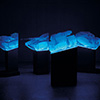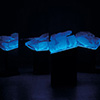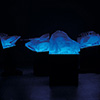EXHIBITED:
Reality Impalpable - A Solo Exhibition by Li Hui, Museum of Contemporary Art Taipei, Taipei, April 29 - June 26, 2011
This work is to be sold with a certificate of authenticity issued by New Age Gallery, Taichung.
Catalogue Note:
Existing sources of light are important elements in the works of Li Hui. Even when presented through modern technologies such as laser or LED lighting, light in Li Hui's highly conceptual works hints at a future that is full of possibility. The light creates an atmosphere full of mystery, in which basic human themes such as religion, war, life, aging, illness, and death are directly portrayed. Among his Chinese art contemporaries, Li exhibits a unique sense of acuity in the use of materials, as well as a distinctive language of expression. His 2007 piece Buddhist Altar No. 2 explores a great many ruminations on religion, technology, and the modern human condition through acrylic light sculpture, a medium he handles deftly.
Buddhist Altar No. 2 uses clear acrylic to construct a sports car; the interior is sculpted into the shape of a Buddha, through the unique characteristics of the material. When the LED light is connected to the sculpture, it emits a blue glow and dimly illuminates a Buddha hidden within the car. The effect is a mixture of holiness and absurdity, but in a darkened setting, it appears both mysterious and mesmerizing. Humans have used advanced technology to create sports cars that are able to achieve astonishing speeds, surpassing that of any natural organism. This represents the advancement of human civilization, as well as the desire to surmount nature. When a Buddha becomes an altar through such modern technology, it symbolizes the icons of religion and modern technology existing side by side, incorporated within each other. This conflict not only creates a sense of visual impact, it also triggers a series of questions and speculations on religion, technology, and desire. What significance does the richly historic Buddhist culture hold in a new era? How should good and evil be defined? These are all questions that require much contemplation. The artist goes further by deftly dividing the sports car into many distinct sections; in turn, the Buddha sculpture within has also broken into pieces. This hints at transitoriness and frailty, both of technology and religion. It acts as a reflection of the many doubts and possibilities that exist in this era of ever-changing values.




